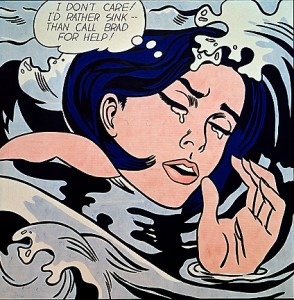“There is no such thing as an original idea.” – Dan Binns. As Dan told us this (again), it didn’t feel very reassuring/inspirational, but as he continued to speak and said that it’s how we “deliver [content] in new and interesting ways [that matters]”, it did start to feel a little inspirational, especially when one of the readings this week was this:
Everything is a Remix Part 2 by Kirby Ferguson.
‘Kill Bill’ (Tarantino, 2003) has so many different references in it, but uses all of them in such a unique way. It is so interesting to uncover the inspiration behind a piece like Kill Bill, especially to find out that so many different pieces worked together to create the one entirely different and iconic film. And that is what the topic of remixing is all about, creating the new from the already existent.
Remixing started around 1929 when the use of synchronous sound in film was popularised. Remixing was popularly used by surrealism, post-cubism and dadaism, not in the same way we know it today, but in the way that they deconstructed footage of objects and people and then edited it in a way so that it created a general theme, such as ‘Ballet Mecanique’ (Leger, 1924), which uses close ups of regular household objects and people, then edits the footage and combines it with sound in such a way that the people seem to be mechanical:
Dan explained the evolution of remix to us through the creation of the DJ (which I will explore in a further post along with the newly created VJ), showing us a documentary on song remixes and one particular DJ, Girl Talk. Girl Talk’s song ‘This is the Remix’ uses 34 tracks:
This immense use of track sampling shows how an original piece of art can be created from already existant works. Other examples of remix art that have come about in recent years are pop art (signifies a society/era with familiarity which is then subverted in strange, unique and ironic ways):
– Roy Lichtenstein’s ‘Drowning Girl’
and glitch art (which breaks the rules of the original form in which the art took place, exploiting a something ‘wrong’ to create something completely different):
Dan spoke to us about many different scholars, including Walter Benjamin, a German scholar whose works originated from the Frankfurt school at Gurter University. His most influential piece (in terms of current ideas on remixing), is ‘The Work of Art in the Age of Mechanical Reproduction’, an analysis of how mechanical reproduction (as opposed to man-made manual reproductions) detract from the uniqueness and authority of the original, as well as lack the “aura” of the original (Benjamin, 1936).
Benjamin’s theories on how reproducing something changes the original product, changes the authenticity of the original product (as it lacks the environment of the original product), as well as how forms of reproduction, such as film, have become a form of art, all contribute in a way to the current views of remix in society. Benjamin goes on to say that film itself is “the most powerful agent” of the “contemporary mass movements”, that its “social significance, particularly in its most positive form, is inconceivable without its destructive, cathartic aspect, that is, the liquidation of the traditional value of the cultural heritage.” (Benjamin, 1936)
I think that Benjamin clearly did not foresee the incredible uniqueness and diversity of expression that has come from film and photography, even programming. Although, I can understand his point of view, as in today’s culture the number of people using a pen and paper as opposed to a laptop is dwindling, and pretty soon art will have taken on an entirely new technological form, and hence a new culture.
Benjamin also brings up the concept of distance, that is a mechanical reproduction does not have sufficient distance in its appearance or structure to be unique to the original in the way a manually recreated piece would. Distance is also brought up in another way by Benjamin, as he speaks of a “detachment” created by the mechanical reproduction, that separates you from the original. This is where Benjamin theorises the idea of the “aura”. The aura to Benjamin is little more than a feeling but, when in the presence of the original, you can feel its aura, due to its history, authenticity and authority as an object, whereas the mechanical reproduction is cut off from this aura as it does not have these same qualities, is not unique and is one of many as opposed to one (Benjamin, 1936).
A physical work of art, such as a painting is planted in a specific time and place, so is more able to have an aura.However, I do feel that there is an element of the aura that Benjamin did not account for in terms of reproductions, as when we watch a film or TV show for the first time in a unique setting, we remember that feeling of that first time watching it, and I know personally that I have tried in vain innumerable times to recreate that atmosphere and hence aura, of that first time watching that film, but as Benjamin says, it’s never the same as the original. In this way, I feel that ‘the original’ could just as easily be transposed to the first viewing.
I also feel that if you own a technological reproduction, such as a poster or a book, and it goes through some wear and tear alongside you, you feel a strong connection to the object and the object gains its own aura and authenticity through a shared history with you. Through these examples, it is to say that Benjamin’s theories of aura and work with all kinds of reproductions, they are just different kinds of auras, as everything has a different aura.
However, what I feel Benjamin is trying to say is that the mechanical reproduction will never be the same as the real physical thing, as it doesn’t have the same history, authenticity or authority, and therefore aura as the original. Quite like how in this day and age social media tries to copy human interaction but miserably fails, as text-text communication just isn’t the same as face-face, as it creates a level of separation between the original and the reproduction that just isn’t surpassable.
Benjamin’s theories on technological reproduction effect our current views on remixing, as they force us to question the originality of such works, and yet Benjamin himself also says that works that are reproduced manually (by hand/man-made) have a uniqueness that machine reproductions don’t. in this way, current remix culture carries with it its own uniqueness and aura, depending on the degree of separation from the original product, as Benjamin puts it.
Eduardo Navas also created his own theory, ‘Remix Theory’ which is based around the web 2.0 and introduction of the cut, copy and paste tools within pretty much every software application available. Navas theorises that the invention and inclusion of such tools in basic sound and video editing programs allowed for the remix to enter the mainstream pop culture. Navas also theorises that through the inclusion of such short cuts and the developments of such technologies “new forms of cultural production that question standard commercial practice” are created (Navas, 2010). Through Navas’ theories we can surmise that in today’s culture, with the ever growing popularity of remixes and mashups, that as Benjamin was concerned with upholding the authority and purity of the original, we are paving the way for a society that thrives on remixing the already existent into something new and unique with its own aura entirely.
Dan summed up his lecture by emphasising the fact that all of these amazing art works wouldn’t be possible without previously made work, and even though they do use someone else’s work, they are also building upon that work and creating something entirely new. Like found footage, it is being used for a different purpose out of context. However, as we all know, copyright infringement law does not see it the same way.
– Binns, Daniel. Lectorial Week 11. May 19th 2015.
– Benjamin, Walter. ‘The Work of Art in the Age of Mechanical Reproduction’. 1936. Available at: https://www.marxists.org/reference/subject/philosophy/works/ge/benjamin.htm
– Navas, Eduardo. ‘Regressive and reflexive mashups in sampling culture, 2010 Revision.’ August 13, 2010. Remix Theory. Available at: http://remixtheory.net/?p=444

